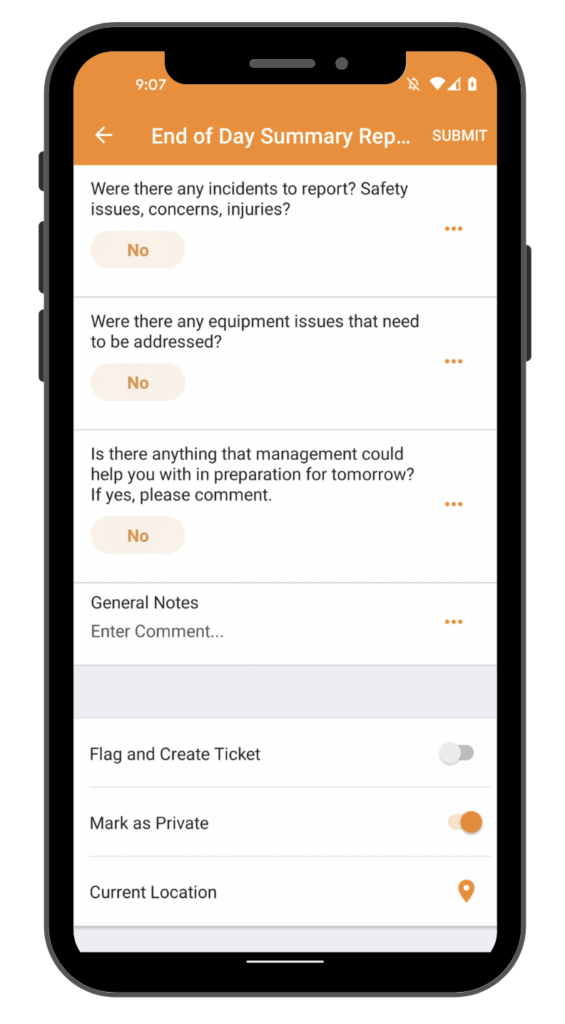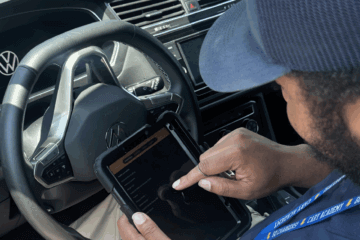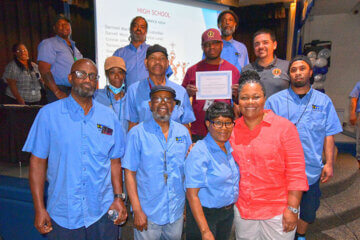End-of-shift inspections are one of the most important forms janitorial, facilities, and custodial teams use. We’re going to explore what end-of-shift report is, who should perform them and why, what makes them so vital, and how to create your own form with sample questions you can use.
Regular inspections are the only way to get a real idea of the efficiency of your janitorial team and how they are performing at your facilities. For more general information about the highest-priority forms to use, be sure to check out our article on the The Three Types of Inspection Forms High-Performing Janitorial Teams Rely On.
What is an end-of-shift report?
An end-of-shift report is a picture of the way things were left at the end of a janitorial team’s workday. It provides your team with a way to address any incidents, violations, or issues with equipment.
End-of-shift reports create an important baseline for measuring performance. This baseline allows facilities managers to discover problems involving their staff quickly, so that they can be addressed and solved before the problem escalates or causes further issues.
As a conclusion to your end-of-day inspection, an end-of-shift report should be filled out to provide you with an idea of how your team members are adhering to the procedures and standards you have set for them.
Any incidents or issues discovered, like failure to follow PPE procedures, uniform violations, or problems with equipment or supplies, can easily be flagged as a deficiency within OrangeQC. (Other janitorial inspection apps may have a different method for indicating deficiencies.) This flag will generate a ticket or email that will open a line of communication with your team members to address the problem, improve efficiency, and empower your team to self-correct and prevent future incidents.
Why perform end-of-shift inspections?
Quality control is imperative to your janitorial team’s long-term success. An end-of-shift inspection allows you to evaluate your team’s performance in real time. The end-of-shift report will also indicate to your employees that you are invested in and care about their success. EOS reports provide your employees with a way to communicate their needs and any issues they are having.
End-of-shift reports create a more unified team from top to bottom because they reward excellence and discover problems in their infancy before they mature into larger issues. Additionally, they provide a catch-all space for escalating safety issues, which is of particular importance if you have team members who work the night shift.
Who should conduct the end-of-shift inspection?
Shift supervisors should be the ones in charge of completing each end-of-shift inspection. If you have a very small team or supervisors are not present for the shift, you may wish to have custodians fill out the forms instead.
In addition to other janitorial inspection forms such as a checklist, EOS reports are an important quality control tool that will greatly improve supervisor communication with team members as well as the overall efficiency of the entire crew.
The OrangeQC dashboard gives supervisors an overall picture of the day-to-day performance of their team members. This tool also benefits employers by showing them that their hires are performing up to their expectations and standards.
What are the expected results of the end-of-shift inspection?
Consistency should be the main goal of any successful shift inspection program. What you hope to find is data that endorses the effectiveness of your janitorial team over a long period of time. Data that reflects consistency shows that everyone on your team is on the same page when it comes to meeting expectations, standards, and quality of work.
The most effective way to achieve consistent results in your end-of-shift inspections is by having a good inspection checklist, especially one that is easy to understand and can be completed quickly. Our Definitive Guide to Creating a Janitorial Inspection Checklist will give you all the information you will need to compile your own checklist, including a downloadable version of our own that you can edit however you like.
What are the standard questions you should ask in your end-of-shift report?
OrangeQC provides you the freedom to design your own end-of-shift report, or you can use the basic template that is already pre-loaded into your account. Remember that the questions you ask on the report should be easy to understand and should be designed to be answered quickly, but also provide you with the level of detail needed to address any problems.
Here are a few examples of the standard questions you can ask in an end-of-shift report:
• Were there any incidents to report? Safety issues, concerns, injuries?
• Were there any equipment issues that need to be addressed?
• Is there anything that management could help you with in preparation for tomorrow?
• General notes
OrangeQC inspection forms allows the supervisor filling out these end-of-day reports a place to provide detailed notes and comments as well as attach pictures to coincide with each question.
Here’s how the pre-loaded form looks in OrangeQC:

End-of-shift reports should have expected questions because you are looking for patterns over time that allow you to better asses your team’s performance. This is imperative for quality control and for gaging efficiency.
What should be excluded in your end-of-shift reports are questions and topics already covered in other janitorial inspection forms. Asking the same questions over different forms is redundant and can feel tedious to the person filling out the forms. Supervisors will be more inclined to fill out end-of-shift reports if they aren’t repetitive and are easy to complete.
What should companies be tracking over time in end-of-shift reports?
End-of-shift reports provide companies valuable data points of their janitorial team’s performance over time. Tracking this data in the long term provides companies with a solid picture of their employees’ morale as well as their performance. Using mobile inspection forms also gives companies a chance to see how efficiently their supervisors conduct inspections.
If communication is key to any quality control program, then tracking end-of-shift reports over time should be paramount. They offer employees and supervisors a line of communication that allows them to resolve issues and reward good performance. This, in turn, improves the overall efficiency of your team.
Answers to questions like, “Are problems quickly resolved?” and, “Do the same issues continually arise during certain shifts?” will become apparent when companies track the results of end-of-shift reports over time. That is the greatest benefit to conducting end-of-shift inspections on a regular basis with your janitorial team.
OrangeQC makes conducting end-of-shift inspections easier, smarter, and quickly available in real time. This makes tracking the data much easier and more efficient for your company.
Want to give it a try for yourself? Start your free 30-day trial of OrangeQC to see how simple and effective using mobile inspection forms can be.



